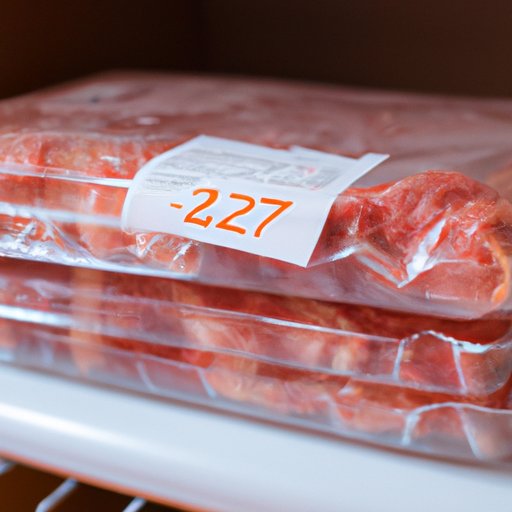Introduction
Storing meat in the refrigerator is a great way to keep it fresh and safe to eat. Knowing how long meat can last in the fridge is an important part of ensuring food safety and preventing spoilage. This article looks at the various factors that affect the shelf life of refrigerated meat, along with some tips on how to make sure your meat stays fresh and safe to eat.
How Long Does Meat Last in the Fridge?
The shelf life of refrigerated meat depends on a number of factors, such as the type of meat, its packaging, and the temperature of the refrigerator. According to the United States Department of Agriculture (USDA), raw meats should be stored in the refrigerator for no more than two days. Cooked meats, on the other hand, can last up to four days in the fridge.
The Shelf Life of Refrigerated Meat
The shelf life of different types of meat varies depending on their fat content and texture. For instance, ground beef has a shorter shelf life than steak or pork chops because it goes bad faster due to its high fat content. Poultry also tends to have a shorter shelf life than other meats. Fish, on the other hand, typically has the shortest shelf life of all, with only 1-2 days in the fridge.
When storing meat in the refrigerator, it’s important to check the expiration dates on the packaging. These are usually printed on the side or back of the package, and they indicate when the meat should be used by. It’s also important to keep track of the “sell-by” dates, which indicate when the product should be removed from store shelves. Finally, there are “best before” dates, which tell you when the product will begin to lose its flavor or texture.
The Dos and Don’ts of Storing Meat in the Fridge
Properly wrapping and sealing meat is essential for keeping it fresh in the refrigerator. Make sure you use airtight containers or bags to keep out any excess moisture. Additionally, avoid cross-contamination by using separate cutting boards and utensils for raw and cooked meats. This will help reduce the risk of transferring bacteria from one item to another.

Maximizing the Freshness of Refrigerated Meat
It’s also important to keep meats away from other food items in the refrigerator. This will help prevent the spread of bacteria and ensure that the meat stays as fresh as possible. Additionally, make sure the temperature of your refrigerator is set to 40°F or below. This will help slow down the growth of bacteria, thus prolonging the shelf life of your meat.
Keeping Meat Safe to Eat by Knowing Storage Times
Knowing the difference between expiration and sell-by dates can help you determine when it’s time to throw out your meat. Expiration dates tell you when the product should no longer be consumed, while sell-by dates indicate when the product should be removed from store shelves. Best before dates give you an idea of when the product will start to lose its flavor or texture.

Prolonging the Life of Refrigerated Meats
If you want to extend the shelf life of your meats, consider freezing them. Freezing can help preserve the quality and flavor of the meat for up to six months. Vacuum sealers are also a great way to keep meats fresh for longer periods of time. Vacuum sealing locks out oxygen and helps prevent spoilage, allowing the meat to stay fresh for up to two years.

Tips for Making Sure Your Meat Lasts in the Fridge
To make sure your meat stays fresh and safe to eat, it’s important to clean and sanitize your refrigerator regularly. This will help reduce the risk of contamination and ensure that the meat remains edible. You should also take steps to prevent spoilage, such as adjusting the temperature settings and properly wrapping and sealing the meat.
Conclusion
Storing meat in the refrigerator is a great way to keep it fresh and safe to eat. Knowing how long meat can last in the fridge is an important part of ensuring food safety and preventing spoilage. This article looked at the various factors that affect the shelf life of refrigerated meat, along with some tips on how to make sure your meat stays fresh and safe to eat. Remember to always check expiration and sell-by dates, and take steps to prevent spoilage, such as proper wrapping and sealing and adjusting temperature settings.


